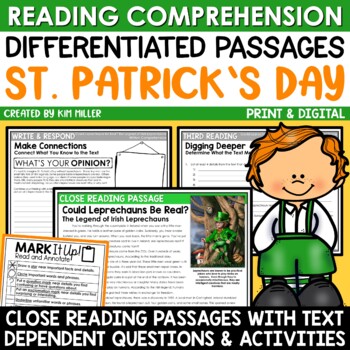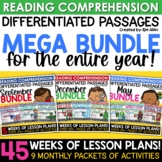St. Patrick's Day Activities Reading Comprehension Passages Close Reading
- PDF
- Google Apps™

What educators are saying
Also included in
- These close reading passages and activities are the perfect tools to help students practice close reading skills during the month of March. Topics include St. Patrick's Day, March Madness, Women's History Month, Daylight Saving Time, and The Rock Cycle. These week-long lessons follow a close readingPrice $12.00Original Price $15.00Save $3.00
- This bundle of printable and digital reading comprehension passages and activities requires students to use close reading skills to practice making logical inferences, citing text evidence, and drawing conclusions from the text. Each week-long lesson follows a close reading model and includes a teacPrice $81.00Original Price $135.00Save $54.00
Description
These St. Patrick's Day close reading passages and activities are the perfect tools to help students practice close reading skills during the month of March. This week-long lesson on Could Leprechauns Be Real? The Legend of Irish Leprechauns follows a close reading model and includes a teacher guide and notes to make teaching the lesson easy! Students will be required to use close reading skills to practice making logical inferences, citing textual evidence, and drawing conclusions from the text.
These differentiated informational text passages about leprechauns will engage students and spark interest! Through reading comprehension and close reading skills, students will learn about the protected area in Ireland designated as the home for all leprechauns. Students will also learn about the discovery of leprechaun remains by a local Carlingford, Ireland man in 1989.
PRINT & GO! Easily differentiate instruction with the leveled reading passages for grades 3-5. Includes everything you need to teach a week-long close reading lesson.
⭐A digital Google Classroom option is included! (Google Slides™)
⭐⭐Bundle and Save! This resource is also included in the following bundle.
Close Reading Comprehension Passages & Questions | March Bundle
Close Reading Lesson:
Could Leprechauns Be Real? The Legend of Irish Leprechauns
This high-interest and engaging topic will captivate the interest of students!
Step-by-Step instructions (for teacher and students) are included that follows a close reading model.
Step 1: First Reading: Determine what the text says.
Step 2: Second Reading: Determine how the text says it.
Step 3: Third Reading: Determine what the text means.
Step 4: Written Comprehension: Write and Respond
Includes:
- Implementation Guide (Steps to Close Reading)
- Teacher Guide and Notes
- Classroom Posters
- Mark It Up! Annotation Cards
- 2 Differentiated Reading Passages
- Text-Dependent Questions
- Vocabulary Practice
- Written Response
- Close Reading Graphic Organizers
Easily Differentiate Instruction!
These close reading comprehension passages are written at 2 different levels to allow for differentiation during instruction. The content of the 2 passages are the same, but the reading levels are different. Questions about the content are the same. This makes it easy for you to provide students with the same questions and activity sheets while also allowing students to practice close reading skills on their reading level.
All answer keys are included!
⭐Note: Each reading passage is leveled with special symbols at the bottom left corner to denote difficulty levels.
This resource is aligned to the anchor standard that refers to reading text closely:
ELA Reading Standard 1: “Read closely to determine what the text says explicitly and to make logical inferences from it, cite specific textual evidence when writing or speaking to support conclusions drawn from the text.”
❤Let's connect!
Click ★HERE★ to follow my store and get notifications about new resources and freebies!
All new resources are 50% off for the first 24 hours!
**************************************************************************************************************************************************
Copyright © Kim Miller (A Love of Teaching). All rights reserved by author. This product is to be used by the original downloader only. Copying for more than one teacher, classroom, department, school, or school system is prohibited. This product may not be distributed or displayed digitally for public view. Failure to comply is a copyright infringement and a violation of the Digital Millennium Copyright Act (DMCA). Clipart and elements found in this PDF are copyrighted and cannot be extracted and used outside of this file without permission or license. Intended for classroom and personal use ONLY.
**************************************************************************************************************************************************







